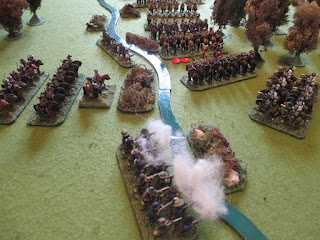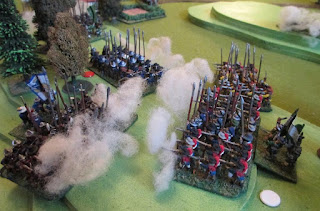My Thirty Years War campaign has progressed into 1619. Two battles occurred, both between the Elector Palatine and the Duke of Bavaria for control of the Upper Palatinate. The first engagement ended in a draw, with the Electoral army having to withdraw; the second action was a resounding victory for the Elector's army and the Bavarians had to abandon the Upper Palatinate.
All the figures are 15mm metal form various manufacturers accumulated over the last forty five years. Most of the trees are homemade )lichen, twig and plasticine base) and are almost as old as some of the figures! Hoses are homemade from matchboxes and card; hills are made from foam sheets. The roads and river were bought (cannot recall the manufacturer), the latter made from mdf painted blue, the former rubber painted a suitable dirt colour and backed with felt.
Here are some pictures of the first battle:
The battlefield, the Bavarians are on the right of the camera, the Electoral forces on the left.
The random battlefield generator produced a lot of scenery for this action, certainly not the more open terrain one would expect for this period.
The battlefield viewed from the other end of the table.
The Bavarian main position, foot and artillery.
The Bavarian left wing was formed from all of their cavalry units.
The Elector's right wing detachment, which harassed the Bavarian cavalry successfully,
but then failed to cross the stream.
Some of the Elector's foot ready to advance; regiments of foot in the foreground and a battalion of Commanded Shot in the background.
The Elector's centre, with cavalry jammed in alongside the stream owing to the lack of space on that side of the battlefield.
Cavalry engaging across the stream, fired on by Electoral infantry.
The view over the village from the Bavarian artillery position. The Bavarian gunners spent most of the game shooting at the Electoral cavalry in the distance, but with mixed results.
The Elector's dragoons join in the firing on the Bavarian cavalry. The counters (not very aesthetic for photos, but all part of a "normal" game!) indicate a unit has suffered reductions in its fighting status: red is still "formed", but black means "unsteady".
The cavalry action in the centre of the battlefield.
There are two types of general bases: mounted, as shown here, and foot. If attached to a unit they give a bonus in combat, help units rally quickly and act more to the general's wishes.
Bavarian foot with a general base - the latter the wrong way round! Encouraging the foot regiment behind with a stirring speech perhaps?
The Elector's foot charging the Bavarian units on the ridge.
The Bavarian unit in the lower right corner has been taken in front and flank by its opponents.
Musketry all along the line. Under the rules, foot have to be stationary to fire,
but can do so twice in a move.
Cuirassiers about to take on light horse.
The Bavarian artillery is attacked. Under the rules, the gunners get a chance to fire, but if contacted by their assailants they are automatically overrun.
The white counter indicates a "disordered" unit, which means the next adverse effect on it will cause it to break and rout.
The end of the battle. The Bavarians have held on successfully on their left and centre. Although their infantry is struggling still against the Elector's foot on the ridge, they latter have not gained a decisive victory.



























Thanks, i enjoyed that ….. and a nostalgia blast seeing the words Plastercine and trees in the same sentence :-)
ReplyDelete